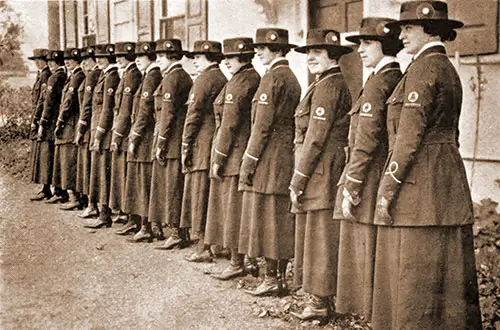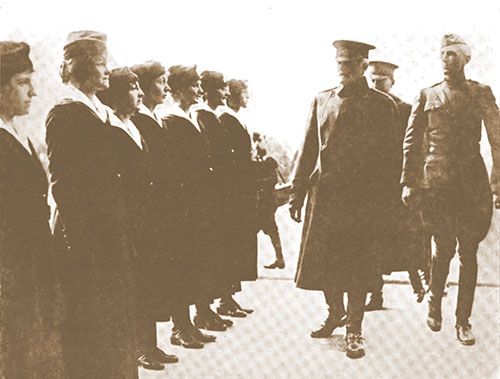How the Signal Corps Organized 100 Girls - 1918

Telephone Operators of the Bell Telephone Company of Pennsylvania, at Camp Dix, New Jersey. Circuits of Victory, 1921. GGA Image ID # 199f93401a
Army Telephone Operators in France Speak Both English and French.
The Division on Woman's War Work, Committee on Public Information, issues the following:
Owing to the problems which the use of two languages presented to the American troops in France, and the necessity of accurate intercommunication between the American and the French Armies, the Signal Corps has sent abroad 100 trained women telephone operators, who speak both French and English fluently, to work in military telephone exchanges in bases of supplies and points of embarkation. During 1917, the Army used men operators and French women for this work. Neither group proved satisfactory.
Gen. Pershing Cables Request

General Pershing Reviewing Signal Corps Telephone Operators of the American Expeditionary Force on the Rhine. Photographed at Divisional Headquarters near Coblenz. The Telephone Review, August 1919. GGA Image ID # 191f61b3f0
Therefore, in the early part of November, a cablegram was sent to the Signal Corps of the United States Army by Gen. Pershing, commander of the American Expeditionary Forces, recommending that, on account of the great difficulty in obtaining suitably qualified men, a force of women telephone operators speaking French and English equally well should be organized and sent to France.
He required three chief operators at $125 a month, nine supervising operators at $72 a month, 24 long-distance operators at $60 a month, 54 operators at $60 a month, ten substitute operators at $50 per month, a total of 100. All should have the allowances of Army nurses and should be uniformed.
Capt. E. J. Wesson, civilian personnel section of the Signal Corps, experienced in recruiting emergency groups of trained workers, was given charge of the proposed unit. Capt. W. S. Vivian was made responsible for the housing and general welfare of the operators in France.
Small Percentage Qualified
Thinking that it might be possible to obtain telephone operators with equal command of both languages in parts of the country with large numbers of French inhabitants, an effort was first made to obtain the group from Montreal, Canada, and Louisiana.
The announcement was placed in French-Canadian papers, with the result that from 300 to 400 women applied. Out of these, only six could be considered. The announcement was then made to the press of the country and telephone companies.
A list of 2,400 applications was received, which yielded two experienced operators who could speak both languages and 25 possible eligible. To this date, 7,600 applications have been received.
Besides the 100 already sent over, 150 fully equipped are now in training schools to meet a possible demand, and a list of 400 as a reserve force is on file.
Classified in Groups
The group of 100 is composed for the most part of French girls who have come to America or American girls who have lived in France. The unit was sent in 3 groups of about 30 each.
Groups No. 1 and 2 are made up of experienced telephone operators. Group No. 3 consists of girls who have been given intensive emergency training in telephony.
These girls come from New York State, California and Massachusetts sent the next largest numbers for the most part. Seventy-two percent are Americans: 28 percent are foreign-born—French, Belgian. Canadian, English, Swiss, and Dutch East Indian.
Under existing laws, wives of Army officers and enlisted men who are liable for duty abroad are not eligible for membership in this unit.
An unauthorized statement, which appeared in many papers, saying that a unit of telephone girls was to be organized and that many women whose husbands were officers had thus found a way to go abroad, occasioned an enormous number of applications and met with an emphatic denial from the Signal Corps.
Rigid Tests Required
Upon filling out the application blanks, which asked for facts about age, nationality, knowledge of French and English, previous telephone experience, and health, and which demanded a promise to serve for the duration of the war.
The candidate whose answers indicated satisfactory qualifications was given an examination by the manager of the local telephone company, who the Signal Corps had authorized.
A full report on the ability and character of the applicant was submitted to a board of experts in New York. A psychologist gave tests to the prospective operators similar to the methods used by the Army in examining officers.
Also, since the work which the unit would perform was of a confidential military nature and would give the members essential knowledge of the movements of troops, Secret Service agents investigated their loyalty and motives for applying for service.
Began Training 12 January 1918
On 12 January, the first group entered the training schools to be trained in advanced telephony. Practice was then given in the largest private branch exchange in New York, followed by three days' work in cantonment telephone exchanges, to acquire familiarity with military terms.
During the period of training military drill was given the women every day. Lectures were delivered to them by officers of the Signal Corps on the duties of that branch of the Army and its traditions.
The importance of the lines of communication in modern warfare was explained, and the various responsibilities of the divisions of the Signal Corps were outlined. Women surgeons gave talks upon personal hygiene.
On 2 March, the first contingent sailed, and later in the month, American officers in France were agreeably surprised by hearing over the military telephones operators who used American terms, gave splendid service, and who could translate the message of a French officer to an American officer, or vice versa.
A second group sailed on 16 March, and a third during the latter part of April. They were stationed in groups of 10 in American bases of supplies and points of embarkation.
The women's Telephone Unit members were required to pass strict health examinations and were inoculated and vaccinated in the same manner as American soldiers.
Out of 60 girls who were immunized, not one fainted. An officer who has seen many soldiers meet the same experience said this was most unusual.
The uniform was designed and prescribed by the War College. It consisted of a blue coat and skirt made of navy blue serge, strictly tailor-made; tailored shirtwaist of navy blue palm beach cloth or similar material; and straight-brimmed hat of blue felt, with the official orange and white hat cord of the Signal Corps.
The brassard on the coat's left sleeve is of white whipcord or doeskin, bearing small devices indicating the status of chief operator, supervisor, and operator.
"It would be impossible to brigade an American troop without these girls," Capt. Wesson, who has recruited the unit, states. "They are going to astound the people over there by the efficiency of their work.
In Paris, it takes from 40 to 60 seconds to complete one telephone call. Our girls are equipped to handle 300 calls an hour. The English Women's Army Auxiliary Corps, the "Waaca," are doing similar work.
Still, they are not equipped with fluent knowledge of French, and the American system of telephony has always been better than the European one.
Personnel of the Units
The personnel of the Woman's Telephone Unit follows:
- Melina J. Adam
- Margaret Anderson
- Albertine Asrents
- Eulalie I. Audet
- Grace Banker
- Julie Barrere
- Marie B. Belanger
- Suzanne M. Beraud
- Frances Paine Bigelow
- Michele F. Blanc
- Margaret S. Bleyers
- Jeanne Bouchet
- Marie L. Bousquet
- Emma Marie Brousseau
- Almería Capistran
- Estelle L. Caron
- Bertha A. Carrel
- Martha L. Carrel
- Suzanne Cohelcach
- Mrs. Inez Crittenden
- Jean Cunningham
- Josephine Davis
- Lucille De Jersey
- Miriam De Jersey
- Frances Des Jardins
- Edith Dodson
- Cordelia Dupuis
- Louise Essirard
- Sara Fecteau
- Marie Floyd
- Marie Louise Ford
- Anna C. Fox
- Esther Fresnel
- Marie A. Gagnon
- Yvonne M. Gauther
- Lydia C. Gelinas
- Louiscttc H. Gravard
- Charlotte Gyss
- Winifred Hardy
- Darnaby Henton
- Matina Heymen
- Adele L. Hoppock
- Bertha M. Hunt
- Elizabeth Hunter
- Margaret Hutchins
- Derise Ingram
- Amallem Jackson
- Janet R. Jones
- Hope Kerkin
- Ethel Keyser
- Florence F. Keyser
- Marie S. La Blanc
- Leontine Lamoureux
- Anns Le Borde
- Louise Le Breton
- Raymond Le Breton
- Martha Libert
- Nellie Martin
- Mrs. Pauline MacDermott
- Blanche Grand Maitre
- Marie Antonette Neyrat McEntyre
- Maude McLowell
- Renne Messelin
- Margaret H. Milner
- Kathleen Mitchell
- Minerva G. Nadeau
- Helen A. Naismith
- Drucilla Palmer
- Lawrence Helene Pechin
- Helen F. Perreton
- Bertha Plamondon
- Marie Ponsolle
- Suzanne Prevot
- Eugenie Racicot
- Minnie R. Richards
- Katharine Hay Robinson
- Dorothy L. Sage
- Georgette Schaerr
- Olive M. Shaw
- Martha Steinbruner
- Marion A. Taylor
- Agnes M. Theriault
- Evelyn Thomas
- Dee Van Balkom
- Bertha H. Verkler
- Lillian V. Verkler
- Isabelle Villiers
- Alice V. Ward
- Ethelyn White
- Mrs. Clara Whitney
"How the Signal Corps Organized 100 Girls: Army Telephone Operators in France Speak Both English and French," in Telephone Engineer, Chicago: Electricity Magazine Corporation, Vol. XX, No. 2, August 1918, pp. 69-70.
